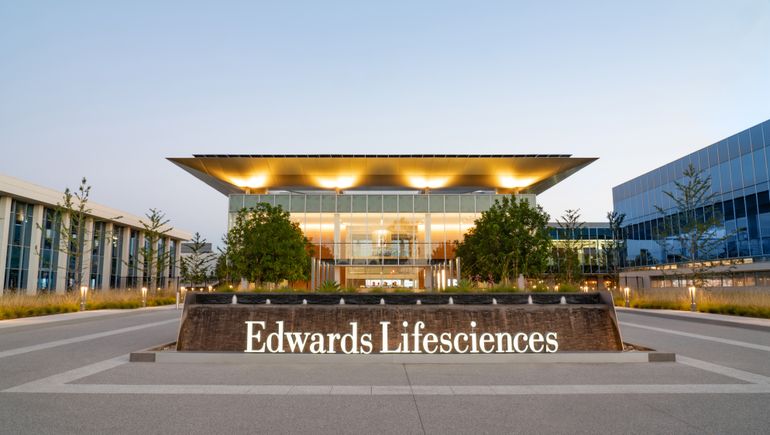By the numbers
Q3 net sales: $1.48 billion
12% year-over-year increase
TAVR: $961 million
11% year-over-year increase
TMTT: $52.4 million
Compared to sales of $29.7 million in the year-ago period
Growth questions
Edwards Lifesciences reported double-digit sales growth for the second consecutive quarter after struggling for much of last year, but Wall Street still has questions about the company’s potential going forward.
The heart device company grew sales 12% year over year to $1.48 billion in the third quarter, in line with analysts’ expectations. Edwards’ transcatheter aortic valve replacement (TAVR) business — by far its largest segment — grew 11% year over year to $961 million.
CFO Scott Ullem said on a Wednesday evening earnings call that TAVR growth “reflected a more balanced hospital staffing environment” and continued adoption of the company’s Sapien valves. He added that the company’s new Sapien 3 Ultra Resilia valve is on track to account for the majority of U.S. TAVR sales before the end of the year.
Despite another quarter of growth for TAVR, multiple analysts highlighted in research reports that third-quarter sales slightly missed expectations.
J.P. Morgan analyst Robbie Marcus questioned executives on the call about the segment’s slow recovery coming out of the COVID-19 pandemic, saying that TAVR sales grew at “much higher rates” before the pandemic.
CEO Bernard Zovighian and Larry Wood, group president of TAVR and surgical structural heart, pushed back on the question, and Wood reaffirmed his confidence in the company’s ability to deliver double-digit growth in the long term.
“This is our third straight quarter of double-digit growth, which coming out of COVID and all the rockiness that we saw during that period of time, it’s actually been really good to see the stability that we’ve seen and the continued growth, even as our business gets larger,” Wood said. “I actually feel really good about our growth rate.”
Marcus wrote that despite the TAVR market remaining under pressure, there are signs of improvement, and Edwards is best positioned to capitalize on the structural heart market with its TAVR and transcatheter mitral and tricuspid therapies businesses.
Other analysts had questions about last quarter and the company’s growth potential. Leerink Partners analysts wrote that Edwards reported earnings that are “largely in line with Street expectations, but that are unlikely to drive positive sentiment amid a recent stretch of volatility for the stock.”
Stifel analysts, meanwhile, were skeptical about Edwards’ future: “Despite another solid total company performance quarter, we expect slower top-line growth as we head into 2024. With the lack of new product launches, challenging comps, TAVR growth slowing, and the overall 2024 growth outlook moderating, we see limited upside for [Edwards’] shares.”
5-year TAVR results
On Tuesday, Edwards released 5-year clinical trial results comparing TAVR to open-heart surgery in low-risk patients. The results showed no significant difference between the procedure and open-heart surgery. Analysts have questioned whether market growth may slow if TAVR does not show a strong enough benefit over open-heart surgery at five years and beyond.
When Wood was asked about the results on Wednesday’s call, he claimed that TAVR does not need to be superior to still drive growth.
“There’s just a little bit of an oddity here that people are discussing that somehow TAVR has to be better than surgery,” Wood argued. “If we have two procedures — TAVR and surgery — and we can go to patients and say, ‘Your results are identical at five years,’ then that’s going to automatically default people to the less invasive therapy.”
Wood explained that there were details that shaped the results, such as the TAVR group having a three-times higher rate of death from COVID-19. He added that Edwards needs to follow the patients up to the 10-year mark, but that the company couldn’t be “any happier about the data.”
2024 outlook
Edwards executives received several questions about 2024, but provided little insight. Zovighian said he was confident about the future, but the company would go through next year’s financial forecast in detail during an investor event on Dec. 7.
Wood may have given a hint at what expectations could be when he said the company believes it can continue to deliver double-digit TAVR growth.
While multiple analysts were more critical of Edwards, others said they still back the company. William Blair analysts wrote that as “macro and staffing headwinds showed another quarter of improvement, we believe that Edwards can deliver on growth expectations as it drives adoption in its current underpenetrated markets.”
BTIG analysts echoed that sentiment, writing that Edwards should be “very competitive in the long term,” but they added that its “market cap already prices in many of the issues going well, including a successful mitral program.”

